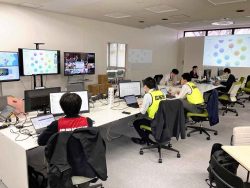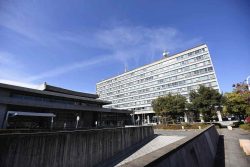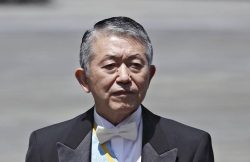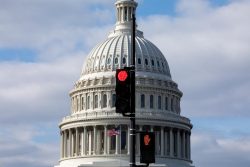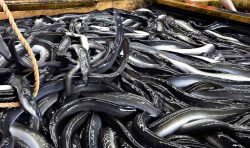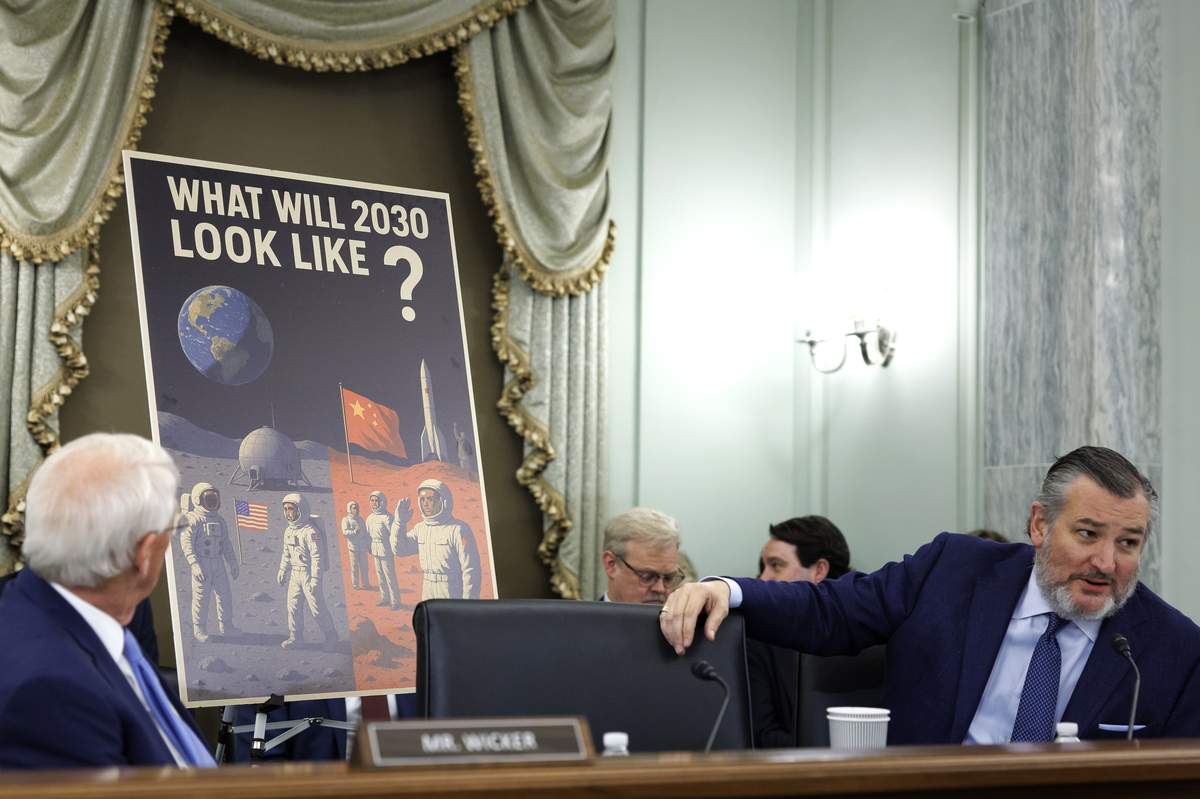
Sen. Ted Cruz (R-Texas) with a poster highlighting his concerns about a space race with China.
13:07 JST, April 21, 2025
As President Donald Trump’s pick to be NASA administrator, Jared Isaacman is going to have to navigate Washington politics, budget constraints and a looming fight over the future of the space agency – a precarious position that may make his historic spacewalk last year, the first by a civilian astronaut, seem easy by comparison.
Trump wants a program to send astronauts to Mars, a course that his adviser Elon Musk, who founded SpaceX for the express purpose of reaching the Red Planet, has advocated as well. In his inaugural speech in January, Trump did not mention the moon but vowed that American astronauts would “plant the Stars and Stripes on the planet Mars.”
Key leaders in Congress, however, are fighting to keep NASA on a path to return astronauts to the moon as part of the Artemis program that Trump created during his first term. They have framed it as a vital national security issue at a time when China has wielded its might in space and is focused on building its own presence on the lunar surface.
“We must stay the course,” Sen. Ted Cruz (R-Texas) said at Isaacman’s confirmation hearing this month. “An extreme shift in priorities at this stage would almost certainly mean a red moon, ceding ground to China for generations to come.”
At the center of the moon-or-Mars tumult is Isaacman, the billionaire entrepreneur and political novice, who flew to space twice with SpaceX, and – if confirmed – will be running the space agency at a time when many fear Musk has an outsize influence that could benefit SpaceX.
As is customary for nominees pending a confirmation vote, Isaacman declined a request for an interview.
Isaacman has said NASA can do both simultaneously – continuing the moon effort, as well as reaching for Mars – despite the fact that there is no real Mars plan or a budget for it.
“I don’t think we have to make any tough trades here, Senator,” he told Cruz during the hearing.
But tough trades are likely as NASA faces budget constraints and a costly roster of space missions in upcoming years.
At least for now, NASA remains on a course for the moon and with a momentum not seen in decades. In March, two robotic, commercial spacecraft funded in part by NASA reached the lunar surface as part of NASA’s Artemis program. Two more uncrewed moon shots are scheduled for this year, including one carrying a rover. NASA’s Space Launch System (SLS) rocket, set to launch a crew of astronauts around the moon next spring in NASA’s Artemis II mission, is nearly fully assembled in the building at the Kennedy Space Center in Florida that was designed for the Apollo-era Saturn V rocket. “Our Moon rocket is coming together more and more everyday,” NASA posted on X above a photo of it.
Assembly of the SLS rocket to be used in the Artemis III mission, scheduled to return astronauts to the lunar surface in 2027, is also well underway. And the Artemis program remains the only deep-space, human-exploration program to survive subsequent presidential administrations since Apollo.
Cruz and many others in the space community are increasingly worried that China could reach the lunar surface before the United States would return. Sending humans to Mars in the next four years, by contrast, is widely considered an impossibility, though Musk has said he hopes to send Starship rockets carrying robots to Mars by next year.
Rep. Brian Babin (R-Texas), the chairman of the House Science Committee, said this year that “one of my greatest concerns is that NASA astronauts will arrive at the moon only to be greeted by a sign that says ‘No trespassers’ in Mandarin.”
Concerned about the Trump administration’s potential shift to Mars, Cruz, the chairman of the Senate Commerce Committee, invited the crew of Artemis II to Isaacman’s confirmation hearing to put human faces on the moon program, according to two people with knowledge of the move who were not authorized to speak publicly. And Cruz pressed Isaacman repeatedly to secure a commitment that, as NASA administrator, he would not abandon the moon.
In his opening statement, Isaacman said, “We will prioritize sending American astronauts to Mars.” But grilled by Cruz and others, he said he would follow the NASA authorization bill, passed in 2022, that calls for a return to the moon under the Artemis program.
Given the existing law, Isaacman said in response to a written question from Sen. Maria Cantwell (Washington), the ranking Democrat on the Commerce Committee, that if NASA’s resources could support only a moon or a Mars program, he would “prioritize the Artemis program,” which calls for a moon landing first. But Isaacman also said that pursuing both “in parallel is not inherently cost-prohibitive.” NASA, he wrote, oversaw the Mercury, Gemini and Apollo programs at the dawn of the Space Age, and “the world’s premier space agency should be capable of executing multiple major initiatives at a time.”
He agreed that the U.S. must beat China to the moon and that the fastest way to do that is to rely on NASA’s existing SLS rocket and Orion spacecraft, at least for the Artemis II flight around the moon and the Artemis III landing, which is tentatively scheduled for 2027. Critics have long said the vehicles are too expensive and should be canceled in favor of commercial rockets such as SpaceX’s Starship or Blue Origin’s New Glenn rockets. (Jeff Bezos, the founder of Blue Origin, owns The Washington Post.)
Isaacman left the door open for significant changes after astronauts return to the moon, saying that “once our initial lunar objectives have been met, I believe NASA should transition from competing with industry and focus again on what no other agency or organization is capable of accomplishing.”
During the hearing, he lamented how for decades various presidential administrations have called for missions to the moon and Mars and that “well over $100 billion has been spent without the intended results.” In a post on X in 2023, he has called the SLS “outrageously expensive” and said it was an example of how “the government is lousy at capital allocation & big prime contractors are incentivized to be economically inefficient and abusive.”
Many believe that the next version of the SLS rocket, to be used in the Artemis IV moon landing and which would use a new, more powerful upper stage, is a prime example of that. A NASA inspector general report last year found that the price tag of the Exploration Upper Stage, or EUS, as it is called, jumped from $962 million in 2017 to nearly $2.8 billion through 2028.
Because the upper stage would increase the height of the rocket, it would require a new mobile launch tower to transport it from its assembly building at the Kennedy Space Center to the launchpad. Another inspector general report found that since the initial contract was awarded to Bechtel in 2019 for $383 million, the cost of the second mobile launch tower is now expected to reach $2.7 billion.
One solution could be to replace EUS with a commercially developed upper stage, according to two congressional aides who work on space issues. But leaders such as Cruz and Cantwell don’t want to see widespread changes to the Artemis program, which they fear would set the U.S. behind China. In December, the senators introduced a new NASA authorization bill, which would direct the space agency to continue with the Artemis program and calls for a “reaffirmation of the Space Launch System.”
But even if it is passed, “it’s all of our concern that regardless of what the law says, the pursuit will be whatever the president dictates and that will be largely shaped by Elon’s vision,” said one aide, who was not authorized to speak publicly about internal deliberations. “We don’t want a fight. We would like to not have space exploration be a real substantial area of disagreement. It has the potential to be a huge win for Trump in his second term and the culmination of his plans from the first term.”
Isaacman’s pledge that NASA could do both without a massive budget increase was, the aide said, a fantasy on par with “low-calorie ice cream that tastes good.”
If Trump remains fixated on Mars and pushes Congress to abandon the moon, many think Republicans would fall in line as they have for many of Trump’s directives, including his tariffs and the cuts Musk has led as head of the U.S. DOGE Service.
But Isaacman has yet to be confirmed, and it’s still unclear how dedicated Trump is to Mars. “Is it number one on my hit list? No, it’s not really,” he said last month in an interview with Fox News. “But it is something that would be, you know, it would be a great achievement. It would be a great thing if we could do it.”
"News Services" POPULAR ARTICLE
-

American Playwright Jeremy O. Harris Arrested in Japan on Alleged Drug Smuggling
-

Japan’s Nikkei Stock Average as JGB Yields, Yen Rise on Rate-Hike Bets
-

Japan’s Nikkei Stock Average Licks Wounds after Selloff Sparked by BOJ Hike Bets (UPDATE 1)
-

Japanese Bond Yields Zoom, Stocks Slide as Rate Hike Looms
-

Japan’s Nikkei Stock Average Buoyed by Stable Yen; SoftBank’s Slide Caps Gains (UPDATE 1)
JN ACCESS RANKING
-

Keidanren Chairman Yoshinobu Tsutsui Visits Kashiwazaki-Kariwa Nuclear Power Plant; Inspects New Emergency Safety System
-
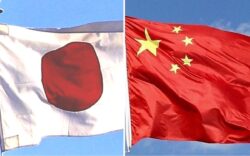
Imports of Rare Earths from China Facing Delays, May Be Caused by Deterioration of Japan-China Relations
-

University of Tokyo Professor Discusses Japanese Economic Security in Interview Ahead of Forum
-

Japan Pulls out of Vietnam Nuclear Project, Complicating Hanoi’s Power Plans
-

Govt Aims to Expand NISA Program Lineup, Abolish Age Restriction












